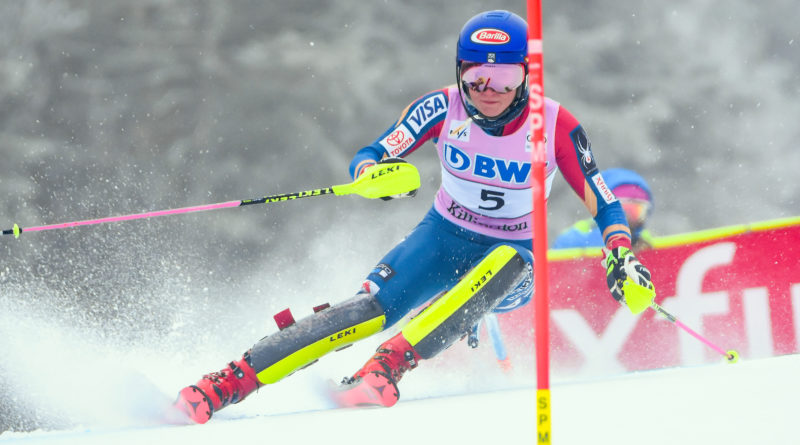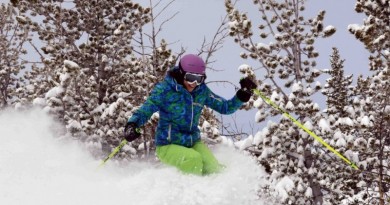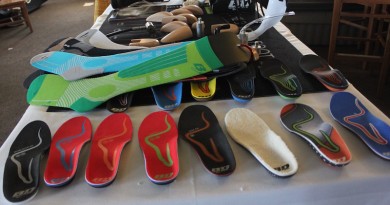Master the 5 Fundamentals of Great Skiing
Good skiers master some of these. Great skiers master all five. Here are the drills you need to up your game this season.
There is one thing that the world’s greatest skiers have in common—be that Mikaela Shiffrin as she charges through the gates at the Killington World Cup, freeskiing phenom Mac Forehand as he launches airs at Mount Snow’s Carinthia Park, or mogul skiers such as Norwich’s Hannah Kearney: They all adhere to five fundamental rules of good skiing. Here, Doug Stewart, a PSIA examiner, bootfitter at Skirack and instructor at Stowe, breaks them down, with drills that will help you up your game.
1. Direct Pressure to the Outside Ski
The fundamental key to skiing well is to get balanced over the downhill or outside ski. This is as simple as saying that turning left is a right-footed turn and turning right is a left-footed turn. While good skiing does involve help from the inside ski, which should stay engaged with the snow while it also tips and turns, the real money is on the outside ski. Drill: Learn to balance on that outside leg and ski by making some turns with the inside ski just barely off the ground, or touching just slightly, while all of your weight is on the outside ski. Make sure the inside ski stays level to the snow; don’t let the tip get higher than the tail. When you can properly balance on only the outside ski through a series of turns, then you will be better balanced to ski on both skis.
2. Control Edge Angles with Inclination and Angulation
Skiing in Vermont is definitely about getting on edge, but how we put the skis on edge can make a huge difference. Tipping the skis on edge involves inclining the body towards the inside of the turn in the direction you are turning, and also involves angulating the upper body back towards the skis, towards the outside of the turn. Most skiers get the tipping into the turn part of edging their skis; they usually do this too much. It’s the angulation of the upper body back towards the outside ski that gets overlooked. Drill: The best way to reinforce good angles is to take a run with your poles dragging in the snow. Keep them just a bit wider than your feet and in line with the front of your boots, and almost totally vertical. In order to keep both poles in the snow while turning, you will need to move the inside hip and shoulder up, and keep the outside hip and shoulder down. This will level out your upper body, to prevent tipping into the turn, and will help your edges work the best they can.
3. Keep the Center of Mass over the Base of Support
One of the toughest fundamentals to master is also the simplest. Good skiers must control their center of mass, so that it can stay over the base of support. In general, stay balanced so you can use the front of the skis and the back of the skis when needed. Many skiers are perpetually stuck in the “backseat.” Only when you have access to the entire length of the skis can you properly shape your turns. Drill: Dial in this type of balance by hopping or bouncing on your skis. If you can find balance over your feet, it will show by the ability to either bounce, or slightly hop and leave the snow at any point in your turn. When you do leave the snow, make sure the skis stay nice and level with the snow surface, to ensure solid balance over the middle of the skis. Challenge yourself by having a friend follow you and call out when they want you to hop or bounce. You should be able to execute the move at any point in the turn.
4. Control the Skis’ Rotation with leg rotation
Everyone loves to watch good bump skiers; it’s amazing to see how well their legs can move and turn independently of their upper body. It’s also fundamental to good skiing that the skis are turned with the rotation of the legs independently of the upper body. Many skiers who aren’t well balanced over their skis don’t have the ability to rotate the legs and turn the skis without turning the entire body. When you find a stance that is centered over your feet, it becomes possible to rotate the thighs, and turn the skis while keeping the upper body and even the hips down the hill in a short turn. Drill: Practice staying balanced over your feet, and turning the legs off to each side while continuing to move straight down the hill—your shoulders and upper body facing the fall line. This proper stance will make for quick feet, and great skiing in all conditions.
5. Regulate the Pressure Created by the Ski/Snow Interaction
The true “je ne sais quoi” of great skiing is a skier’s ability to have “touch.” Good touch is what makes a skier look like they are floating down the hill with no effort. Once a skier is balanced front to back, and side to side on the skis, has proper angles, and is turning the legs, there is a chance to have good touch. Being able to leave the snow when you want, and being able to stay on the snow when you want are good examples of this. When a skier is balanced over the boots and skis, the legs can be supple, and relaxed, and can adjust for changes in the terrain. This is the opposite of a skier who is leaning back and bracing against their outside leg and holding on for dear life. That skier is going to be thrown into the air unintentionally by the next bump. The best drill for dialing in this fundamental is to ski lots of types of terrain. Go find powder, breakable crust, ice and anything else off the groomers. That will help build your touch!
Featured Photo Caption: Mikaela Shiffrin demonstrates impeccable form at the 2017 Killington World Cup. Photo by Alex Klein.



